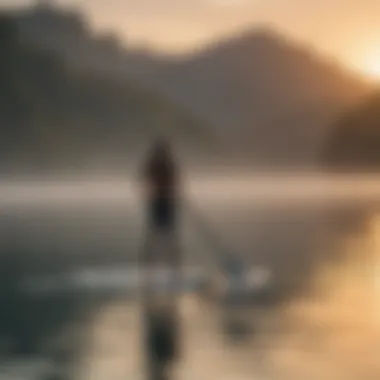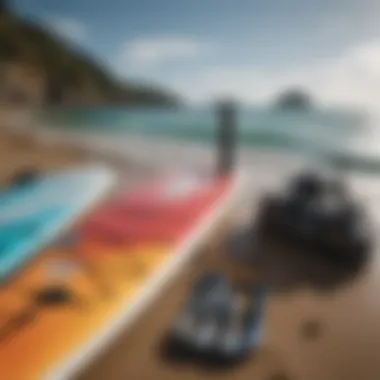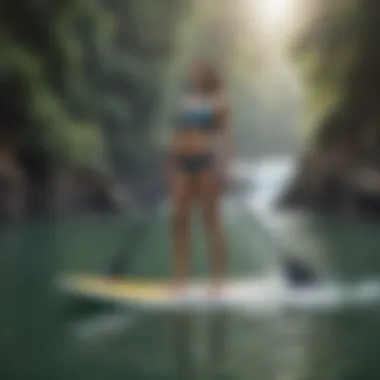Understanding Stand Up Paddleboarding: An In-Depth Guide


Intro
Stand up paddleboarding, often known simply as SUP, has taken the outdoor sporting world by storm in recent years. From sun-washed beaches to serene lakes, this exhilarating activity has captured the hearts of many. But what is it about paddleboarding that has drawn in such a diverse crowd of enthusiasts? This article will shed light on the multifaceted nature of this sport, tracing its origins, detailing the essential equipment, and examining the array of techniques and skills it demands.
Paddleboarding is more than just a sport; it’s an experience that blends physical activity and nature, providing a perfect outlet for both adrenaline seekers and those looking for a peaceful connection to water. The inclusivity of this sport is remarkable, appealing to everyone from seasoned athletes to families looking to spend a sunny afternoon on the water.
Now, let’s dive into what you need to know about the gear that fuels the paddleboarding adventures.
Prolusion to Stand Up Paddleboarding
Stand up paddleboarding, commonly known as SUP, has rapidly emerged as a well-loved water sport that appeals to many. As a blend of traditional surfing and canoeing, this sport offers a unique experience that invites both adventure seekers and casual paddlers to enjoy the outdoors. The charm of SUP lies not only in its accessibility but also in its versatility. Whether gliding peacefully on a lake, tackling ocean waves, or exploring river currents, paddleboarding caters to various lifestyles and preferences.
This article aims to delve into the significance of stand up paddleboarding by exploring its different facets. The essence of paddleboarding extends far beyond simply standing on a board and paddling. It nurtures physical fitness, encourages community interaction, and promotes a deeper appreciation for our natural waterways.
The importance of understanding paddleboarding can be felt in its community spirit. Paddleboarding thrived during the pandemic when many sought outdoor recreation. Now, locals and tourists alike leverage there opportunities for fitness, adventure, and socialization at lakes, beaches, and rivers worldwide.
Paddleboarding is also praised for its low impact on the body, making it an appealing option for individuals across age groups. Not only does it enhance strength and balance, but it also fosters a meditative experience while connecting with nature. With its growing popularity, knowing the ins and outs of paddleboarding helps practitioners maximize enjoyment and safely navigate potential challenges.
Some key elements to consider when exploring the world of SUP include:
- Equipment knowledge: Understanding different types of paddleboards and accessories is fundamental to choosing the right gear tailored to individual needs.
- Techniques: Familiarizing oneself with basic and advanced paddleboarding techniques ensures safety and enhances overall experience.
- Environmental impact: Paddleboarders must take into account the environment they frequent. This sport can either support eco-friendly practices or damage delicate ecosystems if appropriate measures are not observed.
"Embracing paddleboarding not only nurtures physical health but also strengthens one’s connection with nature, building community among enthusiasts of all backgrounds."
The journey into paddleboarding presents an array of opportunities, whether one is a novice keen on learning or an experienced paddleboarder looking to refine skills. From understanding the craft's history and evolution to practical tips on techniques and gear, this article will illuminate all essential aspects of paddleboarding, making it a comprehensive guide for any enthusiast.
Historical Context of Stand Up Paddleboarding
The roots of stand up paddleboarding are deeply woven into the fabric of various cultures throughout history. Understanding this historical context is crucial not just for appreciating the sport's current form, but also for recognizing its evolution and significance. Paddleboarding has traveled through time, adapting to the needs and environment of its practitioners. By tracing its journey, we can appreciate both the cultural and physical aspects that make this sport unique.
Origins in Ancient Cultures
Long before it became a mainstream sport, paddleboarding can be traced back to ancient civilizations. In the coastal regions of Peru, the indigenous people known as the Huari employed simple wooden planks to navigate their waters, primarily for fishing and transportation. These early versions of paddleboards were not just utilitarian; they played a significant role in their culture and survival.
Similar practices existed in Hawaii, where early Hawaiians used large boards called olo as they paddled out to catch fish or simply surf the waves. This interconnectedness with the ocean was a way of life.
"The ocean is a source of connection, and these ancient practices helped to build a relationship with it."
The paddleboarding activities of both the Peruvians and Hawaiians were less about leisure and more centered on practicality. As communities depended heavily on the ocean, their methods of navigating it were essential. This foundational aspect of paddleboarding underscores its importance in ancient cultures.
Evolution into a Modern Sport
Fast forward to the 20th century, and paddleboarding began to undergo a transformative shift. The sport started gaining traction in the 1930s when Duke Kahanamoku, a Hawaiian waterman and Olympic swimmer, showcased the technique in Waikiki. What was once just a practical method of getting around evolved into a leisurely pastime, combining elements of surfing and canoeing.
In the 1950s and 60s, paddleboarding found a new home in Southern California, where it became a popular sport amongst surfers. The boards changed too; they became lighter and more specialized, enabling a more diverse group of people to engage in paddleboarding.
Now, paddleboarding enjoys a global presence, with a range of styles and competitions attracting thousands of participants. From recreational paddling on calm lakes to adrenaline-pumping competitions in turbulent waters, the sport has certainly come a long way from its humble beginnings.
The significance of understanding the historical context of stand up paddleboarding cannot be overstated. It highlights the rich tapestry of human interaction with water and showcases how necessary and enjoyable paddleboarding has been through ages. This historical narrative continues to inspire both new and experienced paddleboarders alike.
Technical Aspects of Paddleboarding


Understanding the technical aspects of paddleboarding is crucial for anyone eager to dive into this versatile sport. The right equipment, alongside proper techniques, can significantly enhance both performance and enjoyment on the water. This section will delve into the necessary gear, paddleboarding techniques, and other vital components that play a role in shaping one's experience on the water.
Necessary Equipment
The gear you choose can make or break your paddleboarding journey. Without the right tools, you might find yourself struggling more than enjoying the ride. It’s essential to familiarize yourself with the various types of paddleboards, paddles, and safety gear available.
Types of Paddleboards
Paddleboards come in various shapes and sizes, each designed for specific activities and water conditions. The main categories include all-rounder, touring, and racing paddleboards.
All-rounder boards are the best for beginners, as they provide excellent stability and versatility. They tend to be wider and thicker, which helps maintain balance, allowing novice paddlers to focus more on enjoying the water than on mastering skills.
On the other hand, touring boards are longer and narrower, optimized for speed and covering distances, suitable for more experienced paddlers.
Racing boards have extreme designs aimed at minimizing drag and maximizing speed, making them perfect for competitions. Each type serves its purpose, and understanding these differences ensures you choose the right board for your level and intentions.
Paddles and Their Specifications
The paddle you wield directly affects how efficiently you can navigate the water. Paddles typically come in varying materials like aluminum, fiberglass, and carbon fiber.
Aluminum paddles offer durability and are usually budget-friendly, but they’re heavier than their fiberglass and carbon counterparts. Fiberglass paddles, striking a balance between weight and cost, are lighter and provide decent performance. Carbon fiber paddles excel in performance but often come with a hefty price tag.
Another aspect to consider is paddle length and blade shape. Longer paddles can provide deeper strokes, but they require more energy to maneuver, while shorter paddles are easier to handle but may not provide the same efficiency on long-distance paddles.
Choosing the right paddle that suits both your height and paddling style is essential for comfort and control while adventuring.
Safety Gear Considerations
Safety gear isn’t something to overlook. A personal flotation device (PFD) is a must, regardless of your paddling experience. Opt for a life jacket that allows freedom of movement and is appropriate for your body size.
Additionally, a leash is critical, ensuring your board remains where you can easily retrieve it should you find yourself overboard. Sun protection is also key. Wear waterproof sunscreen, or consider a long-sleeved rash guard to shield against harmful rays.
Paddleboarding Techniques
Once you’ve got your gear sorted, having the right techniques under your belt will elevate your paddleboarding skills. Mastering the basics can set you up for success in more advanced maneuvers.
Basic Posture and Balance
Good posture on the paddleboard keeps you upright and enhances your stability. Stand with feet shoulder-width apart, knees slightly bent, and engage your core to maintain balance. Keeping your head up and looking forward instead of down at your feet allows you to read the water’s surface better.
This posture not only helps with stability but is also fundamental when learning more complex moves later on. With practice, you’ll find your balance improving, which leads to greater confidence and enjoyment on the water.
Strokes and Steering
To effectively navigate your path, proper stroke techniques are key. The forward stroke powers you ahead while the reverse stroke allows for effective stopping. Using a low, efficient stroke with proper body rotation helps achieve speed without exhausting oneself.
Learn how to switch sides and perform a sweep stroke to turn your board seamlessly to the right or left. Good steering techniques can make the difference between a leisurely paddle and a tiring endeavor. The right strokes can make it feel like you're gliding over the water effortlessly.
Advanced Maneuvers
Once you’ve become comfortable with the basics, diving into advanced maneuvers can be exhilarating. Techniques like turning with a pivot or learning to ride waves can add excitement to your paddleboarding experience.
These tricks require practice and a keen awareness of your board’s balance and your body’s center of gravity. While mastering these maneuvers can be challenging, the sense of achievement you feel when you land them is undeniably rewarding.
The beauty of paddleboarding lies not just in the calm of the water, but in the skills you develop along the way, enhancing your overall experience.
[Note: Invest time into practicing various techniques in a safe environment to build comfort and skill before heading into more challenging waters.]
Embracing the technical aspects of paddleboarding prepares you not only with the right gear but also the necessary techniques that help you enjoy every moment on the water.
[For more information on paddleboarding and its various forms, check out the articles on Wikipedia] or visit Reddit communities.
[Note: This article should be complemented by personal experiences in the sport, ensuring that community-driven information and stories also enrich understanding.]
Physical Benefits of Stand Up Paddleboarding
Understanding the physical benefits of stand-up paddleboarding (SUP) is pivotal not just for aficionados but for anyone interested in fitness or outdoor activities. Engaging in this sport offers a range of advantages that extend beyond mere enjoyment. As the paddleboard glides over water, enthusiasts experience an invigorating workout that can lead to significant health improvements, making it essential to explore these benefits in depth.
Full-Body Workout
When you pick up a paddle, you're not just enjoying a leisurely day on the water. Each stroke activates multiple muscle groups, providing a healthy workout that engages your arms, legs, back, and core all at once. As the paddle slices through the water, your arms and shoulders work hard to propel you forward, while your legs stabilize your body on the board. This full-body workout is akin to doing a core and balance exercise simultaneously, making it an excellent alternative to traditional gym workouts.
- Muscle Engagement: With every stroke, your biceps, triceps, and deltoids are at work, effectively toning your upper body.
- Leg Strength: Your legs not only balance the board but also utilize the quadriceps and calves intensively.
- Cardiovascular Benefits: Excitingly, SUP can elevate your heart rate to boost cardiovascular health. This leads to improved stamina and endurance over time, as you find yourself capable of paddling greater distances with ease.


Studies indicate that participating in paddleboarding for as little as 30 minutes can burn between 300 to 400 calories, depending on weight and intensity, proving that it's a fantastic way to shed some pounds while having fun.
Enhancement of Core Strength
Stability is key when it comes to paddleboarding, which brings us to one of its biggest hidden benefits: core strength. Balancing on the board while paddling is no small feat, as it requires constant engagement of the abdominal muscles. The more you practice, the more robust your core becomes, enhancing overall stability and posture throughout your daily activities.
- Core Engagement: Every time you turn or shift your weight on the paddleboard, your core muscles stabilize your body, fostering better strength and flexibility.
- Posture Benefits: Strengthening your core can translate into improved posture on land. Participants often find that their back pain diminishes significantly, as the exercises naturally align the spine.
- Increased Balance: Developing core strength contributes directly to better balance, which is especially beneficial for athletes and outdoor enthusiasts who engage in diverse sports.
Mental Well-Being
The mental benefits of paddleboarding should not be overlooked. Beyond the physical workout, being out in nature instills a sense of peace and tranquility. Gliding over water, surrounded by scenic views, has a meditative quality that allows individuals to disconnect from daily stresses. The gentle rhythmic motion of paddling can clear your mind, focusing on the sound of water and the beauty surrounding you.
- Stress Relief: Many paddleboarders report feeling a significant reduction in stress levels after their sessions, akin to yoga but with the added bonus of being in nature.
- Mindfulness: Practicing mindfulness while paddleboarding allows individuals to appreciate the environment, promoting gratitude and a deeper connection with nature.
- Social Connections: SUP can also be a social activity, where people gather, share experiences, and form bonds that contribute to overall happiness and emotional health. This community aspect is essential, as positive relationships are linked to better mental health.
In summary, the physical benefits of stand-up paddleboarding not only enhance well-being through extensive workouts but also play a critical role in mental health improvement. Engaging in this sport could transform one's health journey, literally steering them in the right direction.
Environmental Considerations
The relationship between stand up paddleboarding and the environment is a delicate dance. As paddleboarders glide across the water's surface, they not only enjoy nature but also interact directly with marine ecosystems. This section focuses on the intricate balance between enjoyment of the sport and the necessity to protect the natural world that makes it possible. By understanding the impact of our activities and adopting sustainable practices, we can ensure that paddleboarding can be enjoyed for generations to come.
Impact on Marine Ecosystems
Stand up paddleboarding can serve as a double-edged sword. From one angle, it offers a chance to connect deeply with nature, providing hours of exploration amidst coastlines and lakes. However, when not practiced mindfully, it can also leave a significant footprint on delicate marine ecosystems.
Here are a few implications to consider:
- Disturbance to Wildlife: Animal habits can be disrupted by paddleboarders. For instance, nesting birds may abandon their eggs if they feel threatened by passing paddlers.
- Damage to Coral Reefs: In coral-rich regions, poorly executed paddleboarding can lead to physical damage to reefs, which are already under stress from climate change and pollution.
- Trash and Pollution: Paddleboarding can create an opportunity for litter, whether it's from paddler's gear or snacks enjoyed on the water. Left unchecked, this can lead to debris building up in our oceans and lakes, harming marine life.
Consequently, a greater awareness of these factors becomes essential for anyone serious about the sport. Protecting our ecosystems is not only a need, but it also enriches the paddleboarding experience itself.
"The beauty of nature is a gift that cultivates appreciation and gratitude. Paddleboarding should be a means to deepen that relationship, not to tarnish it."
Sustainable Practices in Paddleboarding
To ensure that stand up paddleboarding remains a viable activity for future enthusiasts, embracing sustainable practices is imperative. Here are some steps paddleboarders can take:
- Choose Eco-Friendly Equipment: Opt for paddleboards made from sustainable materials. Some companies are now producing boards with minimal-impact production methods or recyclable components.
- Stay In Designated Areas: Familiarize yourself with the local guidelines. Paddling in designated zones minimizes the risk of disturbing wildlife.
- Practice Leave No Trace Principles: After enjoying a session on the water, always pick up any trash—yours and others. Carry a trash bag or a small net to collect floating debris.
- Educate Fellow Paddleboarders: Share knowledge about the importance of keeping our waters clean and the ecosystems secure. Sometimes, all it takes is one passionate paddler to spark a movement.
- Choose Local Waterways: Opt for local rivers, lakes, or coasts instead of traveling long distances. This reduces carbon footprint and also allows you to discover gems close to home.
By incorporating these practices into your paddleboarding routine, each outing can transform into a positive contribution to environmental wellness. Protecting our waterways is not just good paddling etiquette; it's a shared responsibility that fosters community and respect.
Stand Up Paddleboarding as a Cultural Phenomenon
Stand up paddleboarding has triumphed over being merely a leisure activity; it's morphed into a cultural movement with a robust community at its core. This aspect can't be overlooked as it encompasses the social connections and shared experiences among paddleboarders. It unites people, creates networks, and sparks meaningful interactions across diverse backgrounds.
This cultural significance arises from several factors, including how paddleboarding promotes appreciation of nature and a commitment to healthy lifestyles. Enthusiasts not only enjoy the sport but also gain a sense of belonging to a vibrant community that advocates for environmental stewardship and outdoor recreation.
"The beauty of stand up paddleboarding lies not just in the tranquility of gliding across water, but in the friendships forged amidst the ripples of change in lifestyle choices."
Community and Networking
The community aspect of stand up paddleboarding is both welcoming and far-reaching. Social media platforms like Facebook and Reddit have groups dedicated to the sport. These communities allow for sharing tips, organizing meetups, and discussing gear or technique, creating a scale of connectivity which was not possible before the digital age.


Additionally, local paddleboarding clubs exist worldwide, providing an avenue for both novices and seasoned paddlers to connect. These clubs often hold events—not just for competition, but also friendly outings aimed at enhancing camaraderie among paddleboarders. Through these interactions, the sense of belonging can greatly enhance one's experience in the sport.
Some common community activities include:
- Group paddles: Often organized in local waterways, where people can socialize, enjoy the scenery, and strengthen their skills together.
- Workshops and clinics: Hosted by experienced paddleboarders or clubs, teaching various techniques and safety measures.
- Environmental clean-up events: Where paddleboarders come together to give back to nature by removing litter from water bodies.
Paddleboarding Events and Competitions
Events and competitions have become more than just contests; they serve as celebratory hubs for paddleboarders of all skill levels. These gatherings are often marked by cheers, community spirit, and compelling displays of skill and artistry on the water. Popular events like the Paddleboard World Championship draw participants and spectators globally, sharing not only a passion for the sport but a collective love for the ocean.
Competitions range from casual, fun races to highly skilled events that assess not just speed, but also agility and technique. Participating in such events often fosters friendships and community bonds that extend beyond the competition itself. Local races may contribute to charitable causes, combining sporting spirit and philanthropy.
Types of Events Include:
- Races: Single-day or multi-day competitions that challenge speed and endurance.
- Surf competitions: Where paddleboarders showcase their skills against waves, often leading to breathtaking displays of athleticism.
- Stand Up Paddle Yoga: A unique event combining wellness and paddleboarding, where practitioners connect with nature while maintaining balance and focus.
The landscape of stand up paddleboarding is more than just flooring the paddle; it encapsulates an ever-growing culture that intertwines adventure, health, and community into a cohesive and rewarding experience.
Challenges Faced by Paddleboarders
Engaging in stand up paddleboarding is not just a leisurely activity; it comes with its own set of challenges that practitioners must navigate. This section highlights the importance of understanding these challenges for anyone keen on enhancing their paddleboarding experience. Wrestling with the elements, maintaining physical well-being, and ensuring safety are paramount for enthusiasts to not only enjoy the sport but to also master it in a safe manner. Recognizing the hurdles enables paddlers to prepare adequately, making their time on the water not only enjoyable but also sustainable.
Weather and Water Conditions
Weather can be fickle, shifting from serene to stormy within hours. Potential paddleboarders must keep a keen eye on forecasts, as wind, rain, and waves can dramatically alter conditions on the water. Gusts can catch even seasoned paddlers off guard, making the experience both difficult and unsafe.
- Wind: A light breeze is fine, but anything over 10 mph can be challenging. Paddlers might find themselves working harder, struggling to maintain balance and control.
- Waves: These can vary based on proximity to coastal features or inlets. Larger swells can present real navigation hurdles.
- Currents: River or channel currents can create tricky situations where paddlers might fight against strong flows. It's essential to learn about the local waterways and their ebb and flow.
Before heading out, checking resources like wunderground.com or local weather stations helps in preparing for whatever elements may arise, thereby ensuring a safer adventure.
Physical Limitations and Safety Risks
Paddleboarding is a full-body workout, but it does take a toll on the body. Knowing one’s limits is crucial. Fatigue can set in quickly, especially for beginners or those unaccustomed to prolonged physical activity on water.
- Endurance: Paddleboarding demands both strength and stamina. As the hours pass, paddlers may find it tough to maintain form, risking injury.
- Balance: For many, especially those new to the sport, balance can be a steep learning curve. Falling into the water is one of the most prevalent risks. Practicing balance on dry land before taking to the water can be a helpful preparation.
- Environmental Hazards: Marine life, sharp rocks, and other underwater structures can pose significant risks not immediately visible. It’s wise to familiarize oneself with the paddling area and recognize potential threats.
"Knowledge is power. For paddleboarding, understanding weather patterns, recognizing one’s physical limits, and being aware of safety measures can make all the difference."
Fostering a proactive attitude toward these challenges ensures not only enjoyable outings but ultimately enhances skill, confidence, and connection with the paddling community. By addressing these vital aspects early on, paddleboarders can embrace the spirit of adventure while keeping safety in their minds.
Closure
In wrapping up our journey through the multifaceted world of stand up paddleboarding, it becomes evident that this sport is more than just a fun activity on the water; it embodies a lifestyle that intertwines fitness, community, and a deeper connection with nature. Understanding the nuances of paddleboarding offers numerous benefits to enthusiasts, newcomers, and advocates alike.
One of the key elements highlighted throughout the article is the physical benefits associated with paddleboarding. Engaging in this sport not only provides an excellent full-body workout but also enhances core strength and fosters mental well-being. For many, it's a way to escape the hustle and bustle of daily life, allowing them to immerse themselves in the tranquility of their surroundings. The rhythmic paddling often parallels the ebb and flow of water, making it a meditative experience.
Moreover, we explored the environmental considerations necessary for responsible paddleboarding. Awareness of marine ecosystems and adopting sustainable practices cannot be overlooked. Enthusiasts have a unique opportunity to advocate for the preservation of the waters they navigate, ensuring future generations can also enjoy the serenity that paddleboarding brings.
The cultural significance of stand up paddleboarding also cannot be underestimated. Events, community gatherings, and competitions galvanize participants, showcasing a shared passion among diverse groups. These activities not only build camaraderie but also amplify shared values around health and environmental mindfulness.
Lastly, the challenges faced by paddleboarders, ranging from unpredictable weather to physical limitations, must be acknowledged. Awareness of these obstacles equips individuals to make informed decisions, enhancing safety and enjoyment.
Ultimately, the expansive scope of stand up paddleboarding invites all types of individuals—surfers, athletes, casual enthusiasts, and environmental advocates—to engage, learn, and thrive. As you paddle forward into this invigorating sport, remember: every stroke connects you not just to the water, but to a growing community and a more sustainable world.
"In every stroke made, we find a connection, not only to the water but to the spirit of adventure itself."
The continuing evolution of stand up paddleboarding promises exciting horizons. As you embrace this adventure, immerse yourself—both in the sport and in the pivotal values it represents.















